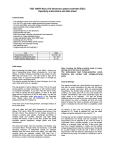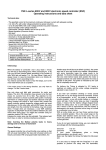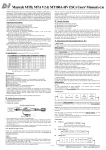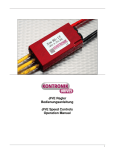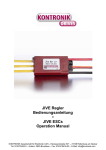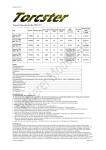Download YGE-8S-12S english
Transcript
YGE 8 S and 12 S electronic speed controller (ESC) Operating instructions and data sheet Technical data: - The specified current is the maximum continuous full power current with adequate cooling. - 2 to 3s LiPo, with under voltage protection by power reduction. - 6 to 9 cells NiMH, with under voltage protection by power reduction. - disconnectable under voltage detection. - BEC: 5V, 2A. - Speed regulation (Governor mode). - Soft start. - Automatic or 6 step adjustable timing. - 5 steps adjustable regular back EMF brake. - Switching rate: 8 to 16 kHz - Speed limit: 240,000 RPM (2-Pole motors) - Temperature and overload warning - Overall dimensions: 25 x 17 x 4 and 5 mm - Weight without / with wires: YGE 8 S: 2,2 / 4,9g, YGE 12 S: 2,9 / 6g. - Programming with the ProgCard II Initial setup: After connecting the battery you hear 3 descending tones. Subsequently, follows a number of beeps according to the cell number of the connected Lipo battery. In case the transmitter stick is in throttle off, you hear now 3 ascending tones. You need to connect the motor to hear the beeps, as it is the motor itself which acts as a speaker. -- The YGE is ready for use. --If the motor turns in the wrong direction, exchange simply 2 of the 3 motor wires. The entire wire length, from the controller to the battery, may not exceed 15cm. If longer wires are necessary, a Low ESR switching capacitor of 330µF/25V should be soldered between plus and minus wires every 20cm. likewise the motor wires can be extended. Then please twist the 3 lines, in order to minimize interference emission. Note: Inverting the Battery polarity leads to heavy damage and to the loss of warranty!!! General Settings: The speed controller has a fixed throttle curve setting, so that with all usual transmitters the stop and full power points are linearly connected. With all programmable transmitters, the throttle range should be set to default (±100%), the center point set to zero and throttle trim enabled. Nevertheless, with some transmitter types the range needs to be adjusted. For that the throttle endpoints have to be set so that one notch before lowest stick position the motor is stopped and that one notch before full power the motor is actually at full power. Full power is indicated by the LED that is completely turned off. On delivery the Timing is adjusted to 18°, brake is switched off, and the under voltage recognition adjusted to Lipo mode 3.0 V. If during spin up rpm variations (wowing or erratic sound) are experienced, the timing must be increased. If no improvement can be obtained at 30°, then the motor is overloaded. Here a smaller propeller, a one cell smaller battery or a stronger motor will help. If after motor stop you hear 2 beeps repeating, it means that the battery voltage dropped down below the setting value. Eventually try a cutoff voltage of 2.9V per cell. If there is still no improvement, then the battery is discharged or too weak, the wires are too long or to small or a connector is out of order. With an active brake you can hear these warning tones only in windmill position. This is the small range on the throttle stick between brake and motor start. You can reach this position with 2 notches or with a high trim and a short gas start. If no automatic timing is wished, it can be adjusted according to the following guideline. Innrunner Outrunner 0 to 12° 18 to 30° If your motor manufacturer indicates a timing recommendation, it is of course preferable to use it. Basic rule: the higher the timing the higher the full power rpm. The easiest to make these changes is the ProgCard II. There is also the possibility to perform the setup with the transmitter; however it will not be explained here. You will find it in the RC-setup manual under www.yge.de in the Download area. In case you get inadvertently in the programming mode during a normal start-up (throttle stick at full power), simply disconnect the battery, lower the stick to stop, and connect the battery again. Thus you won’t modify the adjustments. Helicopter settings For helicopters in governor mode, the full throttle range (100%) must be calibrated once. For some transmitters, this range is indicated in the helicopter menu (throttle curve 0-100%). This throttle curve will then correspond to the controller throttle from 0 to 100%. Please refer also to ProgCard or RC-Setup manual. When activating one of the governor modes, all relevant heli parameters are set to default. This default will fit nearly all setups. You don’t need to program further at a first step. You achieve smaller currents by using a smaller propeller or a one cell smaller battery. BEC: If you want to use an additional receiver battery, the red wire of the BEC connector needs to be disconnected. If you want to use a buffer battery insert a 1A schottky diode on the red wire with the cathode going to the receiver. The buffer battery avoids tension drops on hard servo maneuvers, protecting the receiver’s functionality. Two or more ESCs can be connected to a single receiver if each BEC is fitted with a diode as described above. A configuration without BEC and with galvanic separation is also possible. For that please use our opto coupler module. Caution: Here a listing of the default settings. - Timing = 18° - Brake off - P-Gain = 0,9 - I-Gain = 0,05 - Startup Speed = Heli middle - PWM-Frequency = 8 kHz ) - Startup Power = Auto 1-32% You should modify these parameters, only if you don’t get the desired success, and if you are sure off all other components. Here except Startup power, are to be selected mainly 8 or 16%. On account of the raised load BEC for a 2s Lipo setup is to be preferred, because heat up with 3s Lipo is to high. Lipo protection / under-voltage protection: Because of the tension driven load adjustment it is possible to fly further with low power, since the battery recovers with smaller load. However, if the tension continues to break in, the motor is switched off. Temperature / overload warning: If the speed controller’s temperature exceeds its limit, because of overloading or lack of cooling, after landing and/or motor stop, a warning signal is issued (3 Beeps in the interval). But the motor is not switched off in flight unless the temperature becomes extremely critical. The partial load operation between half and nearly full power is the most difficult area for an ESC. In addition the running time becomes longer and longer with the Lipo technology. If it should come to repeated temperature warnings, better cooling should be provided or current should be reduced. These warnings are to be regarded as overload warnings and not as normal operating condition. Because at high temperature the components are strongly stressed, this leads to a decreased life time. You achieve a better cooling not only through sufficiently dimensioned air intake, but even more efficiently through a larger air outtake, in order to avoid a heat accumulation. Fundamentally it is important to make sure that no objects are within the propeller circle when batteries are connected. The use of this speed controller is therefore allowed only in situations where damages and personal injuries are impossible. A damaged governor (e.g. broken, damaged by polarity inversion or humidity) must not be reused under any circumstances. Otherwise it can come to a later malfunctions or failures. The ESC may only be powered from batteries, a use from power supplies is not allowed. Trouble shooting: The ESC stores any error happening during flight and signals it acoustically (motor) and optically (LED). The errors 5 and 6 are not cleared after a tension RESET. The deletion can take place only on purpose by connecting the battery with the stick at full power and/or with 100% throttle pre-selection, and disconnecting it again after the interval beep. Please you leave the stick at full power, while disconnecting, otherwise you activate the RC-Setup. In case of an enabled brake, the error signaling is performed only after a power reset or in windmilling position. 2 Beeps/flashes: Under-voltage identification 3 Beeps/flashes: Temperature rise warning 5 Beeps/flashes: Receiver signals failed 6 Beeps/flashes: start up failed Warranty: We give 6 months warranty on this speed regulator. Any other requirements are excluded. That applies in particular to requirements for damage or injuries compensation due to malfunction or failure. For damages to property or personal injuries and their consequences, which developed from our supply or craftsmanship, we do not take any liability, since we have no control on handling and use.




